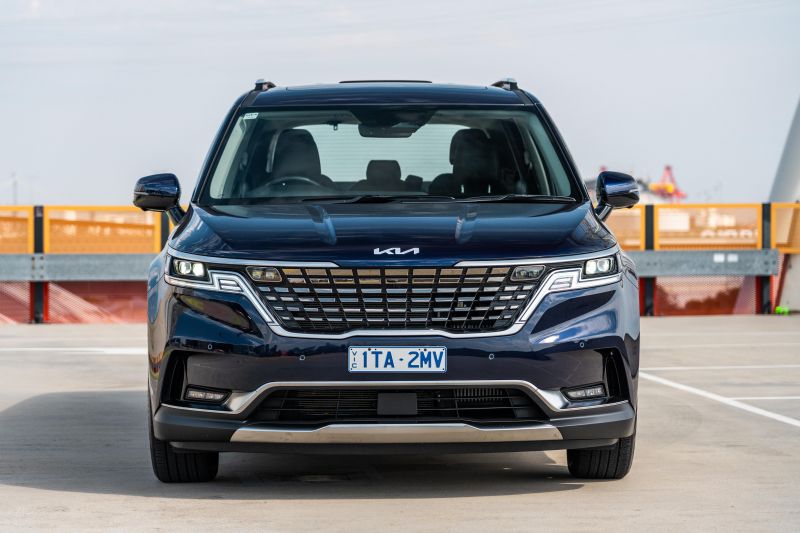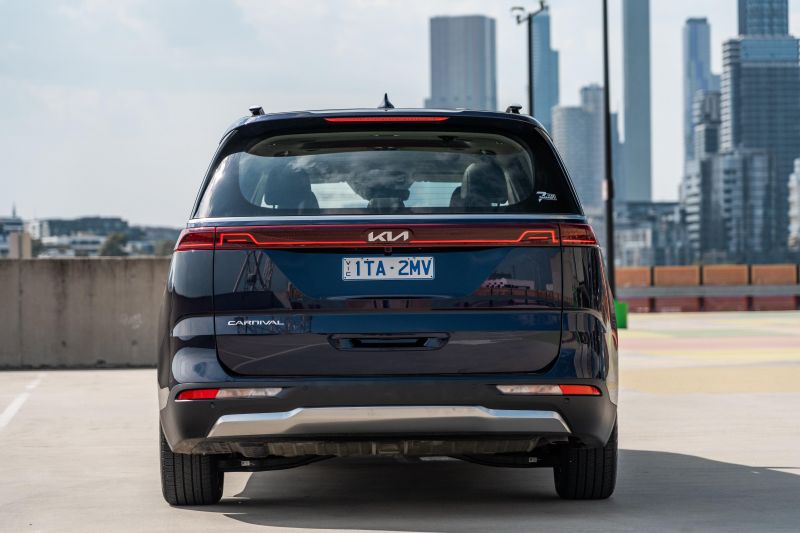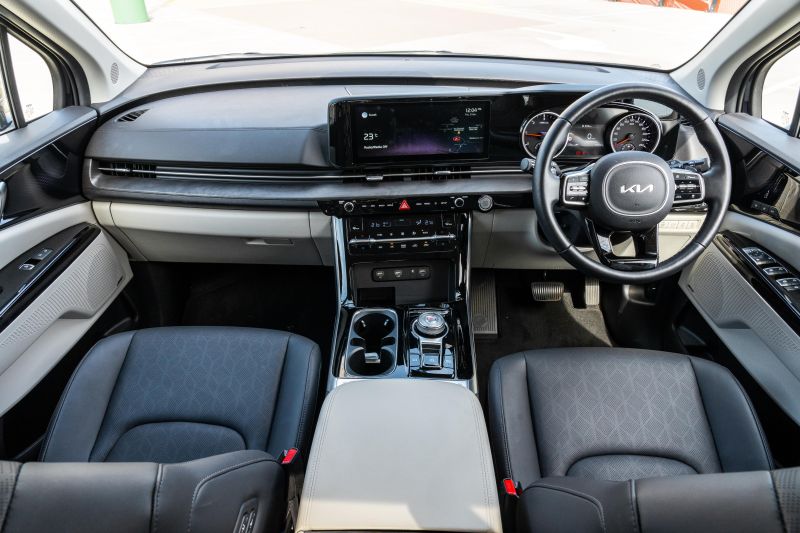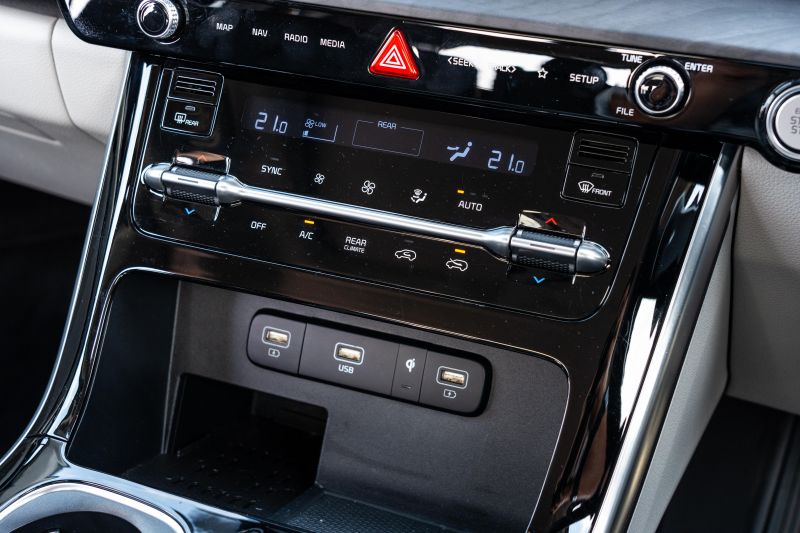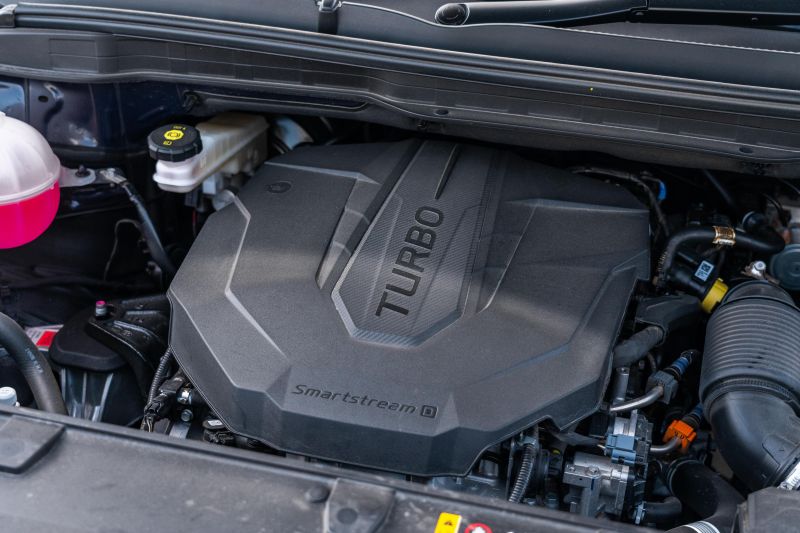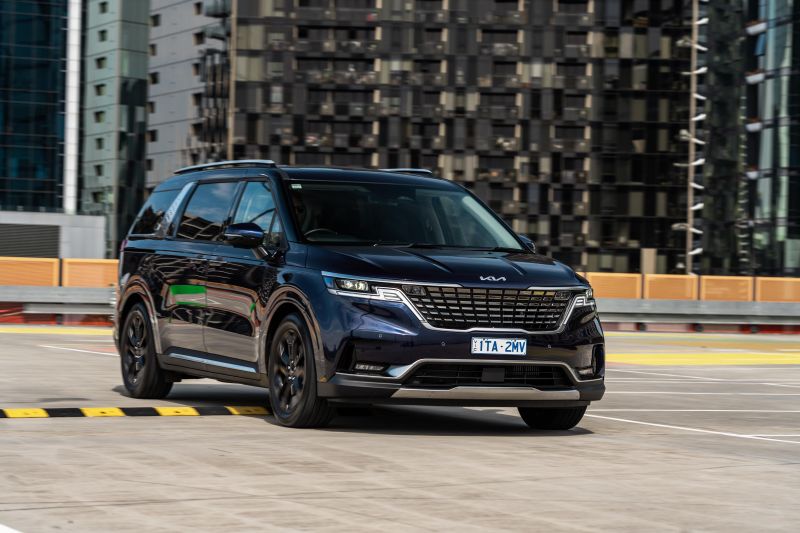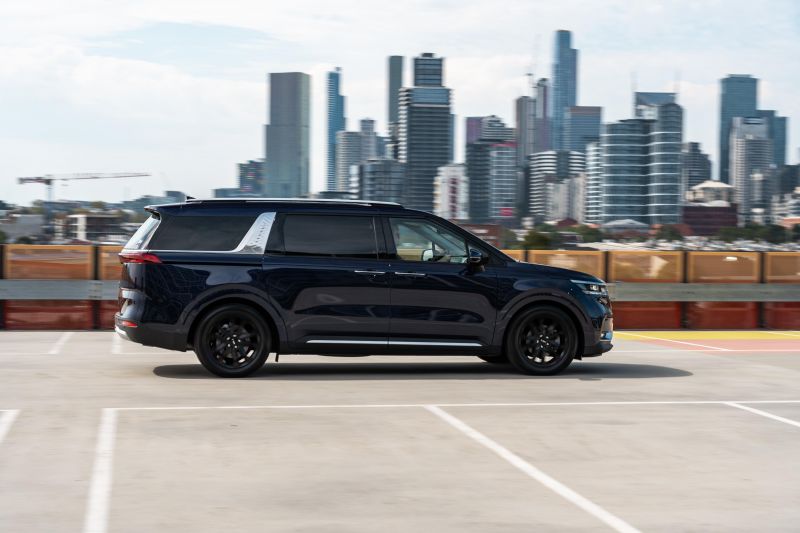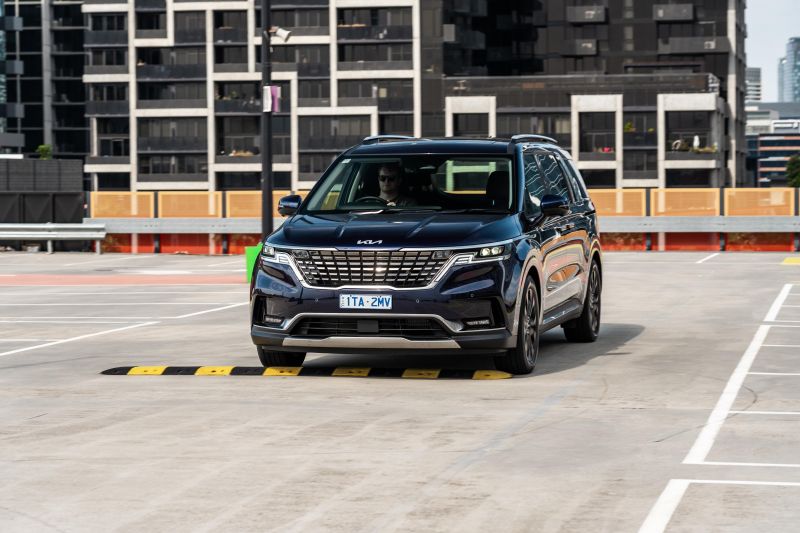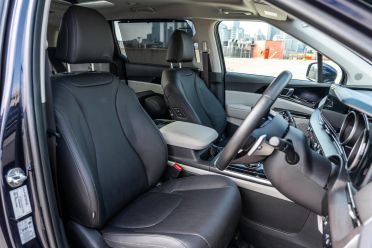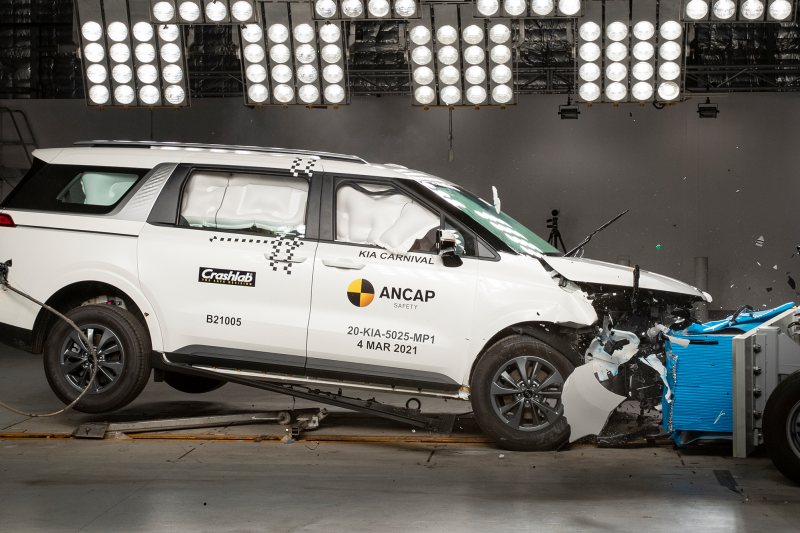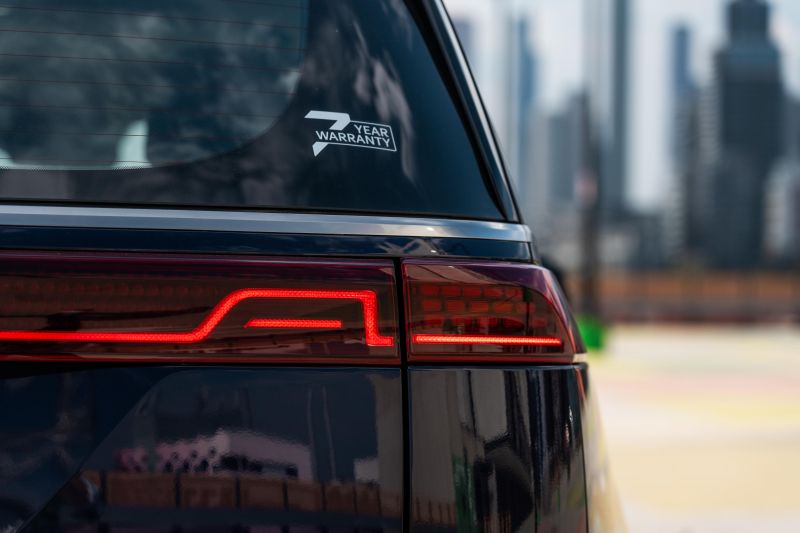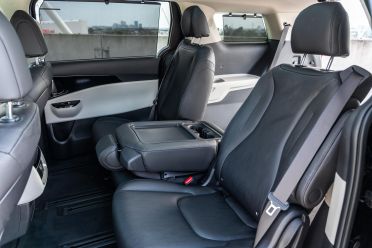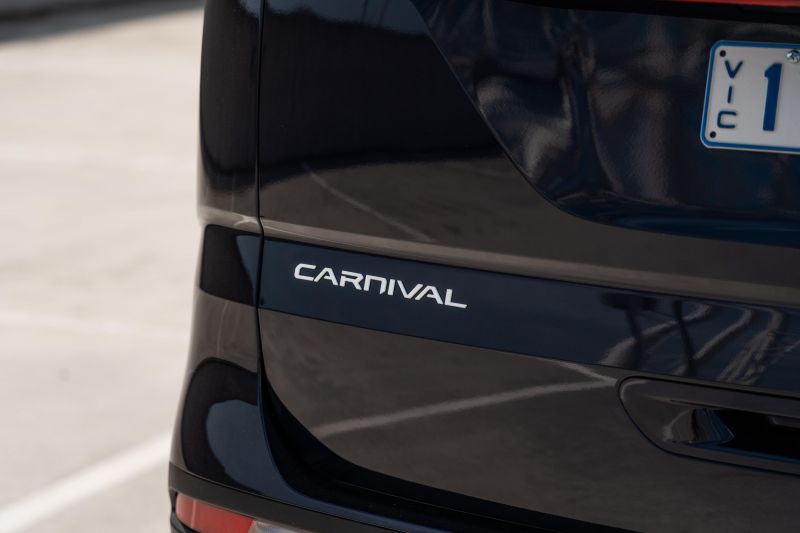“Make people movers great again” – clearly that was Kia’s motto with the Carnival.
Following on from its top-selling predecessor, the current fourth-generation Kia Carnival as asserted its dominance over the MPV segment even further since its launch in 2021 – capitalising on the demise of segment stalwarts like the Honda Odyssey and Toyota Tarago.
Where its forebears were unashamedly frumpy vans focused primarily on maximising space for people, Kia decided to do what Honda did with the third-generation Odyssey of the 2000s and try to make people movers sexy again – this time, by making it look more like an SUV, or ‘Grand Utility Vehicle’ as Kia called it at launch.
Sporting a longer bonnet, chunkier bumpers and overall a more adventurous look, the Kia Carnival has clearly struck a chord with crossover-loving Australians.
The biggest Kia in Australia is so popular it now owns some 85 per cent of the local people mover under $70,000 segment, and wait lists are out the wazoo. It outsells its next closest rival in volume – the related Hyundai Staria – by almost 10 to 1.
Here on test we have arguably the most in-demand Carnival variant in Australia too, the 2023 Kia Carnival Platinum 2.2D.
Local customers’ love for top-of-the-range variants has seen the Platinum account for the bulk of the Carnival’s local sales mix, and the hardest hit by wait times and supply constraints.
With a facelifted model on the horizon, is it still worth lining up for?
How much does the Kia Carnival Platinum Diesel cost?
Remember the people who said “I’ll never pay more than $60,000 for a Kia”?
The diesel-powered Carnival Platinum is the ultimate variant in Australia; priced from $67,580 before on-road costs or $71,890 drive-away based on a Melbourne postcode.
It represents a $3000 premium over the 3.5-litre V6 version, which has been very tight for supply in recent times.
That puts it in line with the likes of the Hyundai Staria Highlander 2.2D AWD ($67,000), LDV MIFA Luxe ($72,990 D/A), Toyota Granvia (from $67,250) and Volkswagen Multivan TDI320 Comfortline ($67,290).
It also serves as a more affordable alternative to the premium-branded Mercedes-Benz Vito Tourer (from $78,515) and Mercedes-Benz V-Class (from $112,816).
2023 Kia Carnival pricing:
- Kia Carnival S V6: $47,480
- Kia Carnival S Diesel: $49,480
- Kia Carnival Si V6: $52,980
- Kia Carnival Si Diesel: $54,980
- Kia Carnival SLi V6: $57,780
- Kia Carnival SLi Diesel: $59,780
- Kia Carnival Platinum V6: $65,580
- Kia Carnival Platinum Diesel: $67,580
Prices exclude the on-road costs
What is the Kia Carnival Platinum Diesel like on the inside?
The Carnival’s cabin hasn’t changed since this current generation launched, but it’s still a benchmark – even if it’s missing promised features available in other markets.
With a more passenger car-like or SUV-like look and feel, the Carnival has a familiar and comfortable vibe inside that’s less utilitarian than most van-based people movers. Nice materials, comfortable seating and excellent cabin space are all highlights.
Up front the driver and passenger are treated to comfortable electric front seats in the Platinum, featuring heating and cooling functions as well as memory presets for the driver.
The front passenger seat has the typical high-end Hyundai/Kia/Genesis chauffeur buttons on the inside bolster, allowing the driver or a rear passenger to adjust the front seat position to allow for more space in the second row or easier access.
Ahead of the driver the Carnival Platinum misses out on the 12.3-inch digital instrument cluster offered locally on the related Sorento as well as the Hyundai Santa Fe and Palisade, which also means it lacks the swish Blind Spot View Monitor cameras that project live feeds into the cluster when you indicate. Shame.
It’s otherwise typical high-grade Kia in the sense it looks and feels upmarket and the infotainment is solid, in the case of the Carnival scoring a larger 12.3-inch touchscreen than the likes of the Sorento and Santa Fe, which make do with a smaller 10.25-inch display that’s otherwise identical in terms of software and layout.
With crisp graphics, quick response and loading times, as well as a relatively fulsome feature suite – including satellite navigation, DAB radio as well as wired Apple CarPlay and Android Auto – the Carnival’s infotainment still remains one of the segment benchmarks.
Small gripes include the ongoing lack of wireless smartphone mirroring in Hyundai and Kia models fitted with embedded satellite navigation, as well as no Kia Connect net-based and remote services – though this will likely be addressed with the upcoming mid-life update.
Audio quality from the Platinum’s 12-speaker Bose-branded premium sound system is likewise very good, offering clear and deep audio without shaking the cabin trims or windows like you’ll find in rival vans – the Hyundai Staria got pretty buzzy at high volume in my experience.
Physical controls for the tri-zone climate controls are welcome, with all the switchgear ergonomically organised and located within easy reach of the front occupants. The volume and tuning dials are also good, given so many rival manufacturers keep adding finicky touch-based switchgear these days.
Storage and practicality are good but not outstanding. There’s a handy tray under the centre stack with a wireless phone charging pad, within easy reach of the trio of USB-A ports – one for smartphone mirroring, the other two for charging – and also accompanied by a small slot for smaller items like keys or a wallet.
A pair of cupholders line the centre console alongside the rotary shift-by-wire dial, ahead of a small tray and a deep cubby under the chunky front-centre armrest.
However, the skinny door bins won’t take larger bottles, which is frustrating when you think of the various shapes and sizes of the sort of bottles and other paraphernalia parents with small children need to carry.
The second and third rows are where the Carnival really stands out compared to a similarly-priced SUV, offering acres of space for kids, adults and cargo the like.
Three individual seats in the second row are teamed with heaps of leg room, knee room, toe room and toe room, with all three pews individually adjustable on rails as well as having adjustable backrests. ISOFIX points are fitted to the outboard seats in both the second and third rows, which will be handy for parents of multiple little ones.
Amenities include manual rear sunblinds on the windows, a fixed sunroof panel that lets plenty more light in, cup holders at the rear of the centre console with a 12V power outlet, USB-A charge ports on the backs of both front seats, as well as roof-mounted air vents with separate climate controls.
The third row is accessible by way of quick release controls on the outboard seats, which fold and slide the second-row pews out of the way once you open the swish powered sliding doors. Even at 6’1 I can get in and be comfortable in the third row, which also has three seats, though it’s not quite as spacious as the second.
You could easily accommodate seven adults across three rows just fine, but eight would be at a pinch due to that skinny centre seat in the third row. Kids will be fine back there, and parents doing driver duty to sports games will love the fact you can fit all the little ones and all of their stuff in the Carnival, which isn’t always possible in large SUVs.
There are also additional USB-A ports, cup holders and a 12V power socket in the rear area, and even with all three rows of seating in use there’s still a massive 627 litres (VDA) of available cargo volume. I’ve fit plenty of bags and holiday gear behind the Carnival’s third row in the past, and it’s very impressive.
When you’re not shuttling your village of family and friends around, the Carnival’s third row of seating neatly folds into the floor, opening up 2785L (VDA) of cargo volume, which is more than most large SUVs with both the second and third rows folded.
You can maximise floor length by sliding the second row all the way forward, and for extra long items you can also remove the centre rear seat entirely for a seven-seat layout. Unfortunately, Australia misses out on the second-row captain’s chairs offered in other markets, as well as Korea’s bus-like 9-seat and 11-seat interior options.
The Carnival’s space-saver spare wheel isn’t mounted under the boot floor. Instead, it’s under the footwell of the second-row seats.
What’s under the bonnet?
Diesel versions of the Carnival are powered by a 2.2-litre CRDi four-cylinder turbo-diesel wearing the brand’s efficiency-focused Smartstream branding.
Outputs are rated at 148kW (3800rpm) and 440Nm (1750-2750rpm), with drive sent exclusively to the front wheels via an eight-speed automatic transmission.
The transmission is the key difference between the Carnival and its Sorento platform mate, with the SUV running the same diesel engine but driving all four wheels via an eight-speed dual-clutch automatic.
Claimed fuel consumption is rated at a frugal 6.5L per 100km on the combined cycle for the diesel. The fuel tank measures 72 litres in capacity.
As noted earlier, the Carnival is also available with a 216kW/355Nm 3.5-litre V6 petrol, which quotes fuel use of 9.6L/100km on the combined cycle.
Diesel versions of the Carnival quote a maximum kerb weight of 2134kg – 2kg less than the V6 – while braked towing capacity is rated at 2000kg with a 200kg maximum towball download.
How does the Kia Carnival Platinum Diesel drive?
If you’re concerned people movers still drive like utilitarian vans, the Carnival is here to prove you wrong.
Sharing underpinnings with Hyundai and Kia’s acclaimed SUV range and featuring a local ride and handling tune, the Carnival is one of the best people movers to drive, irrespective of pricing and segmentation.
It has a really familiar, car-like or crossover-like feel to the way it gets around, with smooth and fluid driver controls, great comfort and refinement, as well as responsive performance.
The turbo-diesel motor under the bonnet of our tester is a great balance of pulling power and economy, and while not as quick or rev-happy as the silky smooth V6 petrol, the oiler canes the petrol for effortless performance and fuel economy.
My time with the Carnival was spent commuting to and from the office during the week in peak-hour traffic through the outskirts of Melbourne’s CBD and the eastern suburbs, and then over the weekend I piled some friends in and headed up to Lake Eildon in Victoria’s north east.
For daily duties, the Carnival is excellent. It’s a pleasant and comfortable thing to live with despite its size, with predictable handling, refined performance and all-round comfort. The Carnival is as at home putting around the suburbs for the grocery run or school drop-off as it is at 100km/h on the freeway.
The diesel engine does exhibit that signature diesel clatter at idle and under hard acceleration, though it’s pretty well-muted compared to some more agricultural commercial van-based competition. It will run out of puff at the top end, so best to drive it in a measured manner to get the best out of it.
Visibility is excellent thanks to the vast glasshouse, and on the flipside the cabin is an airy and spacious place to be, aided by the Platinum’s dual-pane panoramic sunroof.
Surround cameras in this specification and big side mirrors make for easy-ish parking – remember this thing is massive – and body control is well sorted when navigating sweeping corners on high-speed country roads as well as when threading through tight city streets.
During my weekend road trip, which included scaling Victoria’s legendary Black Spur, the Carnival impressed with its secure handling and tight body control. Despite its size, it doesn’t handle like a land yacht.
With all 440Nm on tap from just 1750rpm, the diesel Carnival has plenty of shove to tackle hills and power out of tight bends, even with four adults on board and plenty of luggage for a weekend away.
If you need to dial up the response, you can flick it into Sport mode which sharpens throttle response, firms up the steering weight and programs the transmission to hold gears longer. I was happier to leave it in the adaptive Smart setting and let the car cycle between profiles itself based on the conditions, and it did a pretty good job.
Insulation from road and wind noise is also impressive for the class, kept to respectable levels and allowing occupants across all rows to maintain a normal conversation on the move.
The Carnival’s upmarket techy vibe carries to the driver assistance suite which is pretty comprehensive, apart from the lack of Kia’s trick Blind Spot View Monitor system that’s been forbidden fruit for our market.
Standard adaptive cruise control and Lane Following Assist (active centring) take the load off longer highway stints, and facilitate what is effectively Level 2 autonomous driving.
It’s one of the better systems on the market in terms of user friendliness, though I understand some drivers won’t like the feeling of the vehicle constantly correcting the steering.
Blind-spot and rear cross-traffic assist also go one step further than ‘monitoring’ systems by autonomously adding steering correction or applying the brakes to avoid collisions with approaching vehicles.
What do you get?
Carnival S highlights:
- 17-inch alloy wheels
- LED headlights
- LED daytime running lights
- Auto headlights, high beam
- 8 seats
- 4.2-inch supervision cluster
- 8.0-inch touchscreen infotainment system
- Wireless Apple CarPlay, Android Auto
- 6-speaker audio
- Air conditioning
- Rear parking sensors
- Tilt-and-telescoping steering wheel
Carnival Si adds:
- 18-inch alloy wheels
- LED tail lights
- Front parking sensors
- 12.3-inch touchscreen infotainment system
- Satellite navigation
- Wired Apple CarPlay, Android Auto
- Leather-wrapped steering wheel, shifter
- Dual-zone climate control
Carnival SLi adds:
- Surround-view camera
- Keyless entry and start
- Power sliding doors
- Hands-free power tailgate
- 10-way power driver’s seat with two-way lumbar
- Auto-dimming electrochromic rear-view mirror
- LED front fog lights
- Rear privacy glass
Carnival Platinum adds:
- Bose 12-speaker sound system
- 19-inch black alloy wheels
- Dual sunroofs
- 12-way power driver’s seat with four-way lumbar
- 8-way power front passenger seat
- Matte chrome exterior trim
- Paddle shifters
- Heated steering wheel
- Heated and ventilated front seats
- Heated rear seats
- Ambient lighting
- LED interior lighting
- Rear occupant alert
- Wireless phone charging
Is the Kia Carnival Platinum Diesel safe?
The Carnival range received a five-star ANCAP safety rating in January 2021.
It scored 90 per cent for adult occupant protection, 88 per cent for child occupant protection, with a 68 per cent and 82 per cent for vulnerable road user and safety assist respectively.
Standard safety features include:
- 7 airbags incl. driver’s knee
- Autonomous Emergency Braking (AEB)
- Pedestrian, Cyclist detection
- Junction assist
- Blind-spot assist
- Driver attention monitoring
- Lane departure warning
- Lane Following Assist (lane centring)
- Lane-keep assist
- Rear cross-traffic alert
- Safe Exit Warning
Carnival SLi adds:
- Around View Monitor (360 cameras)
- Rear cross-traffic assist
- Safe Exit Assist
How much does the Kia Carnival Platinum Diesel cost to run?
As with the wider Kia range, the Carnival is covered by a seven-year, unlimited-kilometre warranty.
There’s also up to eight years of complimentary roadside assistance if you service within Kia’s authorised dealer network, and there’s capped-price servicing for the duration of the warranty period.
Scheduled maintenance is required every 12 months or 15,000 kilometres – whichever comes first. Prices per visit are listed below.
Kia Carnival 2.2D service pricing:
- 1yr or 15,000km: $356
- 2yrs or 30,000km: $616
- 3yrs or 45,000km: $430
- 4yrs or 60,000km: $805
- 5yrs or 75,000km: $400
- 6yrs or 90,000m: $784
- 7yrs or 105,000km: $425
As noted earlier, combined fuel consumption is listed at a claimed 6.5L per 100km on the combined cycle, not bad for a big bus.
I achieved an indicated 7.5L/100km during my week of testing, which is a little up on the claim but pretty good nonetheless, considering I mixed in peak-hour commuting in the city with some freeway driving and a road trip out to Lake Eildon in Victoria’s north east with people and kit on board.
Based on the 72-litre fuel tank, my real-world fuel consumption would equate to almost 1000km between fills.
CarExpert’s Take on the Kia Carnival Platinum Diesel
It’s plain to see why the Carnival is currently the sales leader in the people mover class.
The big ol’ Kia isn’t just the people’s choice, it’s an objective benchmark for MPVs across both mainstream and premium brands thanks to its near-perfect blend of comfort and utility.
It drives well too, and there’s something to be said about the fact it’s not an SUV like everything else on the roads these days – even if Kia calls it a Grand Utility Vehicle (GUV).
The diesel is the pick of the powertrain range too. No, it doesn’t offer all-wheel drive like the Hyundai Staria 2.2D or the related Kia Sorento, but the oiler is otherwise well suited to carting around the entire family and then some, whilst also maintaining a very respectable level of efficiency to keep running costs low.
Few other vehicles on the market are as well-equipped to handle whatever families can throw at it, and it’s far less compromised in terms of cabin packaging to an equivalent SUV – no way a Sorento will haul what this can.
Like I mentioned earlier, Kia should be applauded for making people movers cool again, much like Honda did nearly two decades ago. Carnivals aren’t just popular with fleets, but also with private buyers despite the current SUV craze.
It’s a shame Australia continues to miss out on various high-end features that would bring the Carnival Platinum in line with other top-spec Hyundai and Kia offerings, such as a digital instrument cluster, automatic wipers, and blind-spot cameras.
Like I said earlier, though, there are few cars on the market that can do what the Carnival can do, especially for the money.
Here’s to hoping the upcoming facelift addresses the above complains, and also brings the mooted petrol-electric hybrid drivetrain that’s already offered in the Sorento, Santa Fe, and soon Sportage in Australia. Kia would only tighten its stronghold on the market with the sole electrified MPV offering in the mainstream class.
Click the images for the full gallery
MORE: Everything Kia Carnival

